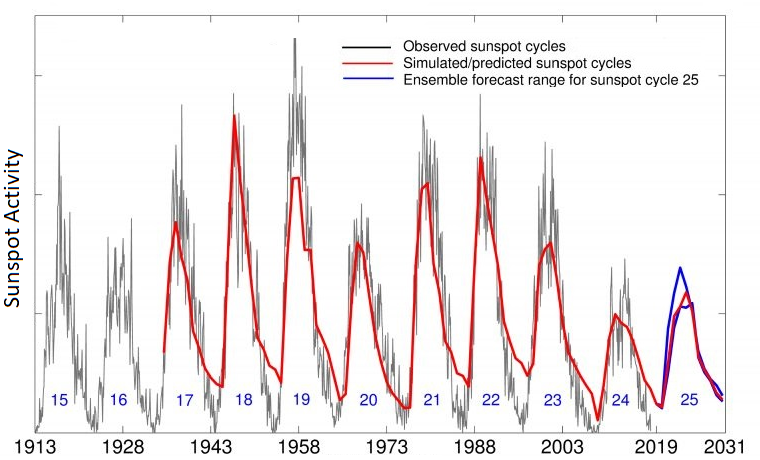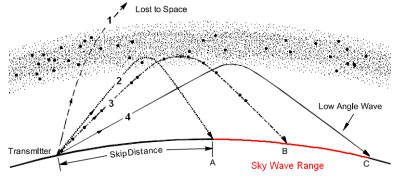Ionospheric Radio Propagation
In the early days of radio communications, it was thought to be impossible to cover
distances well beyond the horizon because of the limited reach of the ground wave
propagation. When trans-atlantic communication was accomplished it was concluded,
that the Earth was surrounded by an electrified layer that caused reflection
of radio waves. Later experiments showed that more than one such layer existed.
They are build up from ionized particles created by the Sun's ultra-violet radiation.
Also cosmic radiation contributes to the building of these ionized layers.
The part of the atmosphere where these ionized layers appear is called ionosphere,
which roughly stretches from 100 km to 500 km above the Earth's surface.
Classification of the Layers in the IonosphereThere are four ionized layers or regions in the ionosphere. They are called the D, E, F1 and F2 layers. All four layers are present during daytime. At night, the F1 and F2 layers thin out and tend to merge into one F layer. The D and E layers disappear at night. These layers have a lower degree of ionization. After the Sun sets, the intensity of the ultra-violet radiation decreases, recombination of the ionized particles occurs and the lower ionized layers will dissolve. Just before sunrise, ionization is at its lowest point. D-LayerThe D-layer, which is present during the daytime only, has the least ionization and therefore has the least effect on radio propagation. However, it almost completely absorbs radio waves of lower frequencies (up to 10 MHz). The ionization is proportional to the angle of elevation of the Sun and is the greatest at noon. E-Layer
The Kennelly-Heaviside layer is a layer of ionised gas occurring between
roughly 90-150 km. It reflects medium-frequency radio waves (up to about 20 MHz),
and because of this reflection, radio waves can be propagated beyond the horizon. F-LayerThe F-layer, or Appleton layer, is the most important reflection layer. The F region contains ionized gases at a height of around 150-800 km above sea level. It has the highest concentration of free electrons and ions anywhere in the atmosphere. During daytime when solar radiation is much higher than during the night time, the F layer splits into two sub-layers: the F1 and F2 layer with average virtual heights of 200 and 500 Km. After sunset these two layers merge again into a single F region. Some Terms and DefinitionsAngle of RadiationThe angle between the direction of the wave propagation and the horizon (or tangent of the Earth) is called wave angle or angle of radiation. This angle is influenced by the characteristics of the transmission antenna - especially the physical length with respect to the wavelength of the radio wave - but also by the properties of the ground below the antenna structure. Ground WaveThe horizontal waves from the transmit antenna travels a line-of-sight distance or a little bit more, parallel to the surface of the Earth. This wave is called ground wave. Critical Angle
The wave at a somewhat lower angle is just capable of being returned
by the ionosphere. This radiation is called critical angle.
Waves transmitted with a higher angle will be absorbed in the ionized layer. Skip Distance and Skip ZoneWhen the wave angle is lower than the critical angle for a particular frequency and for a particular constellation of the ionosphere (time of the day), it is reflected and returned to the surface of the Earth some distance away from the location of the transmitter.
Multi-Hop PropagationNot only the ionosphere, also the Earth itself can act as a reflector for radio waves. This can result in a transmission consisting of multiple hops.
As indicated in the picture, the distance at which a ray eventually reaches the Earth depends on the height of the active ionospheric layer and the elevation launch angle at the transmitting antenna. Usable Frequency
In order to reach a certain point on the Earth, the appropriate
frequency and radiation angle must be chosen.
This highly depends on the constellation of the ionosphere
(sunspot cycle, time of the day, height of the ionized layers) and the antenna used.
Although world-wide communication is possible through
multiple reflection on the ionospheric layers and the surface of the Earth,
the best possible quality is obtained with as little
hops as possible. Sunspot Activity
Everything that happens in radio propagation on the Earth is highly affected
by the atmospheric radiation from the Sun.
The variable nature of radio propagation on the Earth reflects the ever-changing
intensity of ultraviolet and X-ray radiation, which are the primary ionizing
sources of solar energy.
The total power radiated by the Sun is estimated at 4.0E23 kW.
At its surface, the Sun emits about 60 megawatts per square meter and
a significant part of that energy is radiated in the radio frequency spectrum by solar flares.
That solar transmitter will interfere with any free
space electromagnetic-based communication on Earth.  Propagation in the HF Bands
Sky wave propagation offers long range communication with low transmit power.
The most difficult question regarding sky wave propagation is what frequency to use.
The radio waves in the HF Bands (3-30 MHz) use the ionospheric reflection
most effectively. 160-m bandThe 160-m band offers reliable working conditions over a range of up to 50 Km during daytime and up to several thousand Km during winter nights. 80-m bandDuring the daytime, the 80-m band covers up to about 300 km. The band is more useful during the night with a range of several thousand Km and regular transoceanic communication during winter nights. 40-m bandThe 40-m band has more or less the same characteristics as the 80-m band but offers even more skip range. Daytime distances of up to 1500 Km and world-wide communication during winter nights. 20-m bandThe best amateur band for DX work is the 20-m band. During the high portion of the sunspot activity cycle, it is open to some part of the world practically throughout the 24 hours of the day. During sunspot minima it is generally useful only during twilight hours. There is practically always a skip zone on the band. 15-m bandThe 15-m band shows highly variable conditions over the sunspot cycle. During sunspot maxima it is useful for long distance work during a large part of the day, but in years of low sunspot activity, it is even unusable during daytime. 10-m bandThe 10-m band is generally considered to be a DX-band during the winter daylight hours and good for local work during the hours of darkness, for about half the sunspot cycle. At the sunspot minimum the band is usually dead. |
| Cover << Sail Away << Marine Radio Communication << Radio Principles << . | last updated: 03-May-2014 |

